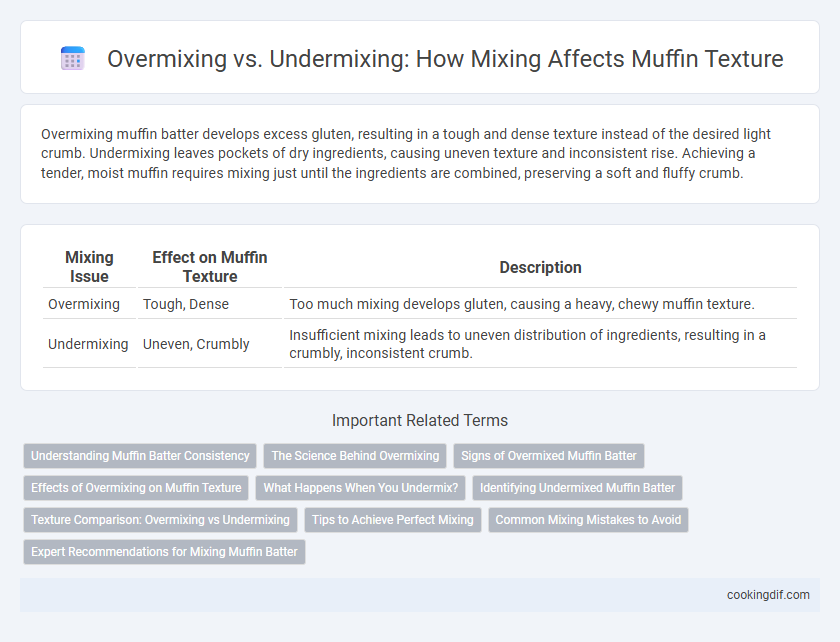Overmixing muffin batter develops excess gluten, resulting in a tough and dense texture instead of the desired light crumb. Undermixing leaves pockets of dry ingredients, causing uneven texture and inconsistent rise. Achieving a tender, moist muffin requires mixing just until the ingredients are combined, preserving a soft and fluffy crumb.
Table of Comparison
| Mixing Issue | Effect on Muffin Texture | Description |
|---|---|---|
| Overmixing | Tough, Dense | Too much mixing develops gluten, causing a heavy, chewy muffin texture. |
| Undermixing | Uneven, Crumbly | Insufficient mixing leads to uneven distribution of ingredients, resulting in a crumbly, inconsistent crumb. |
Understanding Muffin Batter Consistency
Achieving the perfect muffin texture relies on understanding muffin batter consistency, where overmixing leads to tough, dense muffins due to excessive gluten development, while undermixing causes uneven crumb and tunnels. Ideal muffin batter should be mixed just until dry ingredients are moistened, preserving a lumpy consistency to ensure a tender crumb and even rise. Monitoring the balance between overmixing and undermixing is crucial for fluffy, moist muffins with a light texture.
The Science Behind Overmixing
Overmixing muffin batter leads to excessive gluten development, resulting in a tough and dense texture rather than the desired tender crumb. The mechanical action of overmixing aligns gluten strands, which traps air and produces a chewy consistency instead of a light, fluffy muffin. Understanding this science helps bakers balance mixing time to achieve optimal muffin texture by preventing gluten over-formation.
Signs of Overmixed Muffin Batter
Overmixed muffin batter develops a tough, dense texture with peaked, cracked tops caused by excessive gluten formation. Visible signs include a shiny, elastic batter that resists folding and creates tunnels or holes in the baked muffins. Recognizing these indicators helps ensure a tender, moist crumb by gently mixing just until combined.
Effects of Overmixing on Muffin Texture
Overmixing muffin batter causes excessive gluten development, resulting in a dense, tough texture rather than the desired light and tender crumb. This leads to tunnels and holes forming within the muffin, negatively affecting its appearance and mouthfeel. Controlling mixing time preserves moisture and ensures a soft, uniform crumb structure characteristic of high-quality muffins.
What Happens When You Undermix?
Undermixing muffin batter results in uneven distribution of ingredients, leading to dense pockets of flour and inconsistent crumb texture. This causes muffins to have a coarse and crumbly structure, preventing proper rise and fluffy softness. The final product often lacks uniformity, with some parts overly dry and others overly moist.
Identifying Undermixed Muffin Batter
Undermixed muffin batter often contains visible lumps of flour and appears uneven in texture, which leads to dense, gummy muffins due to insufficient gluten development. The presence of dry pockets and streaks of unmixed ingredients signals incomplete blending, resulting in inconsistent rising and a coarse crumb structure. Proper mixing should achieve a uniform, slightly lumpy batter without large clumps, ensuring a tender, moist muffin texture.
Texture Comparison: Overmixing vs Undermixing
Overmixing muffin batter develops excessive gluten, resulting in a tough, dense texture with large tunnels and a peaked top. Undermixing causes uneven ingredient distribution, leading to dense, gummy spots and a coarse crumb. Achieving the ideal muffin texture requires just enough mixing to blend ingredients while preserving tenderness and a uniform crumb structure.
Tips to Achieve Perfect Mixing
Achieving the perfect muffin texture requires careful mixing to avoid overmixing, which causes dense, tough muffins, and undermixing, which leads to uneven crumb and tunnels. Gently fold wet and dry ingredients just until combined, leaving some small lumps for a tender crumb. Use a light hand and mix with a spatula, stopping as soon as the flour disappears to maintain optimal muffin fluffiness.
Common Mixing Mistakes to Avoid
Overmixing muffin batter causes excessive gluten development, leading to dense, tough texture and peaked tops, while undermixing results in uneven distribution of ingredients, causing tunnels and coarse crumb. Achieving the ideal muffin texture requires gently folding ingredients until just combined to maintain moisture and a tender crumb. Avoid using high-speed mixers or prolonged mixing to prevent common mistakes that compromise fluffiness and rise.
Expert Recommendations for Mixing Muffin Batter
Expert recommendations emphasize gentle mixing to avoid overmixing muffin batter, which can develop excess gluten and result in a dense, tough texture. Undermixing, however, might lead to uneven ingredient distribution and batter pockets, causing inconsistent crumb and airiness. Achieving a tender, moist muffin requires combining ingredients until just incorporated, ensuring optimal texture and rise without compromising softness.
Overmixing vs undermixing for muffin texture Infographic

 cookingdif.com
cookingdif.com